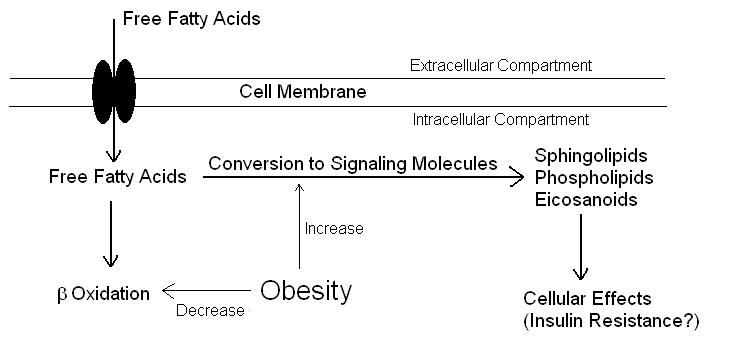Obesity levels are rising in Western nations and research implicates the development of metabolic syndrome as the main cause of the epidemic. Metabolic syndrome, also called syndrome X, is a condition characterised by resistance of muscle cells to the effects of insulin, which prevents them taking up glucose from the blood. This results in a raised blood glucose level and increased transport of glucose into adipose cells, where conversion to triglycerides occurs. Left unchecked, those who develop metabolic syndrome are far more likely to go on to develop type II diabetes, cardiovascular disease and cancer. Exactly what causes insulin resistance in not fully understood, but it is becoming clear that intramyocellular fatty acids (fat droplets stored within skeletal muscle cells) may play a role in the development of insulin insensitivity in the muscle cells.
Athletes have high levels of intramyocellular fatty acids, which are used as energy during exercise. However, athletes tend not to suffer from insulin resistance and so it is unlikely that intramyocellular fat is the sole cause of insulin resistance. Obesity is characterised by raised levels of circulating fatty acids (600 to 800 µmol/L compared to 300 to 400 µmol/L) in the plasma. These fatty acids are taken up by skeletal muscle but for some reason are not oxidised in obese individuals. These fatty acids saturate the intramyocellular fat droplets and then spill over into the production of various signalling molecules such as sphingolipids, eicosanoids and phospholipids. Its is the abnormally high concentration of some of these molecules that are thought to play a prominent role in the desensitisation of the skeletal muscle cells to insulin (figure 1).
 Figure 1. Possible explanation for the insulin resistance associated with metabolic syndrome.
Figure 1. Possible explanation for the insulin resistance associated with metabolic syndrome.
The reason for the elevated fatty acid levels in obese individuals is controversial, but mounting evidence in pointing towards over consumption of fructose as a contributory factor (here). Unlike glucose which can be metabolised by all body cells, fructose can only be handled by liver cells. When glucose enters liver cells, its rate of conversion through glycolysis to acetyl CoA is limited by a feed back mechanism which results in citrate inhibiting the enzyme phosphofructokinase. This is important because acetyl-CoA is used to form fatty acids which are released to the circulation (de novo lipogenesis). Fructose differs from glucose in that it is able to by-pass the phosphofructokinase enzyme and feed into glycolysis at a lower point, resulting in an uncontrolled conversion to acetyl Co-A and a raised production of free fatty acids (compared to glucose).
Dealing with metabolic syndrome therefore requires the issue of high circulating free fatty acid to be dealt with. Avoiding fructose is an obvious solution, because it limits de novo lipogenesis in the liver. Fructose is found in fruit, but generally individuals do not eat enough fruit to cause serious weight gain. However, if weight loss is a goal, it might be worth while avoiding any fruit that contains high amounts of fructose. Sucrose (sugar) contains a molecule of fructose bound to a molecule of glucose and should be avoided entirely if weight loss is a goal. Likewise high fructose corn syrup has no place in a weight loss regimen. In addition, exercise is important because increasing β oxidation of fatty acids will reduce the intramyocellular stores and decrease the production of signal molecules from fats.
RdB
